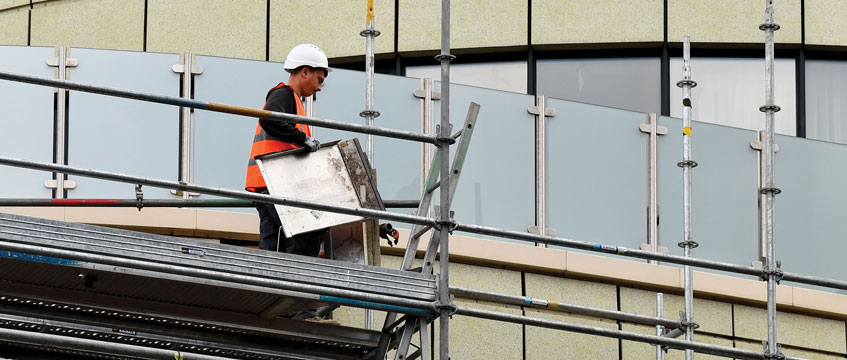Since the Grenfell Tower tragedy, the government’s measures have forced developers and building owners to inspect their residential tower blocks for compliance with new combustibility standards. Where cladding has been found to be non-compliant, they have been duty-bound, almost invariably, to replace it at very considerable cost.
Regulatory change
The law has just undergone a fundamental change. The government’s “consolidated advice note” on the combustibility assessment of cladding has been replaced by the Publicly Available Specification 9980 2022 (PAS9980).
This encourages a more flexible and pragmatic approach to the fire risks in existing blocks of flats. This ultimately means that developers and building owners need be less concerned with the strict statutory compliance of their existing buildings, and fewer buildings are expected to require intrusive fire assessments and façade repair works.
PAS9980 directly applies to blocks of flats and student accommodation. However, it is likely to have implications for the commercial property market as “the methodology set out in this PAS can be applied to a broader range of building types, including non-residential buildings”.
Proportionality and cost-effectiveness
Key to this new methodology is “the importance of proportionality in relation to fire risk and associated mitigation measures”. Considerations of “benefit gained, practicality and cost” are just as relevant as strict legal conformity. It characterises the government’s previous approach as “very conservative”, giving rise to “excessive caution”.
In addition to the cladding material and configuration, wide-ranging criteria are now to be considered, such as means of escape for occupants and the ability of fire and rescue services to intervene in time.
PAS9980 acknowledges its fire safety methodology is “inevitably subjective” and “reliant on the use of professional judgement” of external wall assessors. This will be no easy task. For example, as nationwide minimum standards for fire service attendance have long been discontinued, a cladding assessor cannot assume the fire service’s response based on national criteria. They will need to gather local information and use individual judgment.
Training is ongoing so that suitably qualified surveyors and engineers are available to conduct PAS9980 assessments.
Tolerable risks to safety
As PAS9980 puts it, if “the residual risk presented by the presence of combustible material in the external walls and cladding is tolerable” as a result of other factors then “there is no need to take any significant remedial action”.
Benchmarks in PAS9980 have been developed based on analysis of real-life fires. It is observed that, while fires did spread extensively over external walls, casualties (beyond the flat of fire origin) were actually rare. Therefore, the cost and time spent replacing cladding may not necessarily lead to a proportionate reduction in the risk to human life.
Therefore, an appraisal may now conclude that , for example, changes in evacuation instructions to occupants, or retrofitted sprinklers, might be more cost-effective and proportionate. Under previous guidance, the wholesale replacement of cladding might have been the required course of action.
The lending market
This is welcome news to developers and leaseholders struggling to sell or refinance flats in buildings that were previously adjudged to be non-compliant. It is hoped that mortgage companies will accept the PAS9980 approach and be increasingly willing to lend against flats in such blocks.
The RICS’ EWS1 form is used by assessors to report the combustibility of cladding to lenders and buyers. It is anticipated this will now take account of assessments under PAS9980 and, in turn, open previously “unbankable” buildings to the market.
Claims against developers/contractors
Recent amendments to the proposed Building Safety Bill will mean developers and landlords of residential towers will be liable for the cost of remediating fire safety issues such as external cladding. The government had already announced an extension of the limitation period for claims against developers to 30 years.
PAS9980 claims it is “not intended to be used as a means to audit design or construction of buildings” or failures to meet “contractual obligations at the time of construction”. However, it inevitably affects property disputes between leaseholders, landlords, developers and subcontractors under existing law and the Building Safety Bill, if enacted.
While PAS9980 does not alter the terms of leases, forward-funding agreements and development contracts, it does regulate:
- (a) whether an instructive inspection should be carried out; and
- (b) if so, the remedial works that might be recommended.
By curtailing intrusive surveys, PAS9980 will limit the discovery of contractual non-compliance by developers, building owners and professionals. Most defects in external wall systems, such as insulation material or improper installation of cavity barriers, are not readily visible from an external inspection.
And PAS9980’s focus on proportionality in relation to remediation is more likely to mean the scope and costs of works (and therefore the quantum of damages recoverable) will be reduced. Conversely, developers may legitimately be able to argue the claimants must mitigate their losses by carrying out more modest risk management or remediation measures justified under the PAS9980 approach.
A common-sense approach
The PAS9980 methodology may mean a building that required wholesale façade replacement under the old regime may now potentially need little or no intrusive works. Therefore, the government’s recent measures, if considered collectively, artfully shift the financial burdens to developers and landlords but also significantly palliate them.
Overall, PAS9980 goes some way to restoring the law’s approach pre-Grenfell to the responsibilities of developers and landowners to existing buildings by reinjecting common-sense concepts of reasonableness and proportionality to building safety.
Dev Desai is a partner in the dispute resolution group at Watson Farley & Williams and a specialist in real estate disputes











